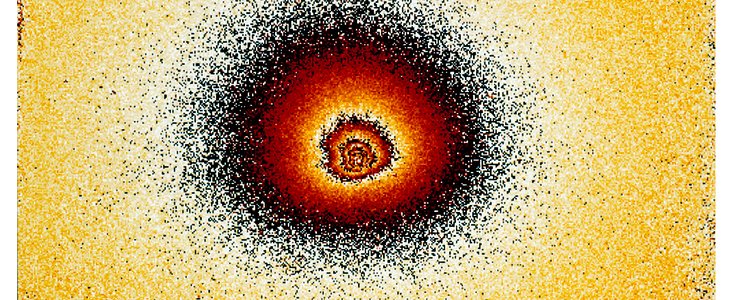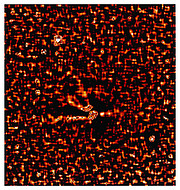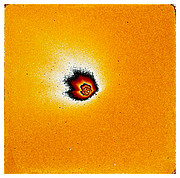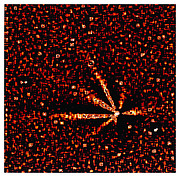Komunikat prasowy
Gas and Dust in Comet Hale-Bopp
23 grudnia 1996
This series of four images shows the appearance of Comet Hale Bopp in early November 1996. At this time it was approaching the Sun in the sky, and these images are some of the last made by a major astronomical telescope in 1996. They were made by Hermann Boehnhardt of the Astronomical Institute of the Ludwig-Maximilian-University in Munich (Germany).
The images were taken at the Danish 1.5-metre telescope with the DFOSC multi-mode instrument on 2 November 1996 around 0 UT. The detector was a LORAL CCD chip (2052 x 2052 pix). The orientation is such that North is up and East is to the left. The pixel size is 0.4 arcsec. At the time of the exposures the comet was just 20 deg above the horizon and still in the twilight sky. The heliocentric distance was 2.49 AU (372 million km) and the Earth distance was 3.05 AU (456 million km). Thus, 1 pix = 885 km. The exposure time was 300 sec (41a+b; CN-filter) and 5 sec (41c+d; R-filter), respectively.
There are four images. The first was obtained in the light of CN-molecules and has been flat-fielded. The field measures about 13.5 x 13.5 arcmin. The second is a Laplace-filtered subframe (width 15 pix) of the first; the field is just over 2 arcmin square. The third was obtained through a red filtre and mostly shows sunlight reflected from the dust in the coma. The fourth is a Laplace-filtered subframe (width 15 pix) of the third; the field is a little less than 3 arcmin square.
In the R filter, it is possible to identify a total of 7 jets at PA = 13, 85, 185, 230, 267, 300 and 332 deg (there is an indication of an 8th very weak structure at PA = 135 deg). The PA (position angle) was measured from North over West (i.e. clockwise from the top on these images). In the CN band, the S/N ratio is much worse and there only seems to be counterparts for the 4 brightest jets in R, but most likely the jets at the the other position angles are not detected.
A comparison of the flat-fielded CN (41a) and R (41c) images suggests that the CN-jets are somewhat wider and smoother than their counterparts in R. This may be a consequence of the gas expansion in the CN jets while the dust as seen in R seems to be better collimated.
If one compares the November R image with the August 1996 image, it is evident that the jet appearances have changed significantly, i.e. the relative intensity varies over a long time scale (order of weeks). However, the position angles remain almost constant. Particularly nice examples are the jets at PA = 13, 185, 267 and 300 deg.
O komunikacie
| Komunikat nr: | eso9643 |
| Legacy ID: | Photo 41a-d/96 |
| Nazwa: | Comet Hale-Bopp |
| Typ: | Solar System Solar System : Interplanetary Body : Comet |
| Facility: | Danish 1.54-metre telescope |
| Instrumenty: | DFOSC |
Our use of Cookies
We use cookies that are essential for accessing our websites and using our services. We also use cookies to analyse, measure and improve our websites’ performance, to enable content sharing via social media and to display media content hosted on third-party platforms.
ESO Cookies Policy
The European Organisation for Astronomical Research in the Southern Hemisphere (ESO) is the pre-eminent intergovernmental science and technology organisation in astronomy. It carries out an ambitious programme focused on the design, construction and operation of powerful ground-based observing facilities for astronomy.
This Cookies Policy is intended to provide clarity by outlining the cookies used on the ESO public websites, their functions, the options you have for controlling them, and the ways you can contact us for additional details.
What are cookies?
Cookies are small pieces of data stored on your device by websites you visit. They serve various purposes, such as remembering login credentials and preferences and enhance your browsing experience.
Categories of cookies we use
Essential cookies (always active): These cookies are strictly necessary for the proper functioning of our website. Without these cookies, the website cannot operate correctly, and certain services, such as logging in or accessing secure areas, may not be available; because they are essential for the website’s operation, they cannot be disabled.
Functional Cookies: These cookies enhance your browsing experience by enabling additional features and personalization, such as remembering your preferences and settings. While not strictly necessary for the website to function, they improve usability and convenience; these cookies are only placed if you provide your consent.
Analytics cookies: These cookies collect information about how visitors interact with our website, such as which pages are visited most often and how users navigate the site. This data helps us improve website performance, optimize content, and enhance the user experience; these cookies are only placed if you provide your consent. We use the following analytics cookies.
Matomo Cookies:
This website uses Matomo (formerly Piwik), an open source software which enables the statistical analysis of website visits. Matomo uses cookies (text files) which are saved on your computer and which allow us to analyze how you use our website. The website user information generated by the cookies will only be saved on the servers of our IT Department. We use this information to analyze www.eso.org visits and to prepare reports on website activities. These data will not be disclosed to third parties.
On behalf of ESO, Matomo will use this information for the purpose of evaluating your use of the website, compiling reports on website activity and providing other services relating to website activity and internet usage.
Matomo cookies settings:
Additional Third-party cookies on ESO websites: some of our pages display content from external providers, e.g. YouTube.
Such third-party services are outside of ESO control and may, at any time, change their terms of service, use of cookies, etc.
YouTube: Some videos on the ESO website are embedded from ESO’s official YouTube channel. We have enabled YouTube’s privacy-enhanced mode, meaning that no cookies are set unless the user actively clicks on the video to play it. Additionally, in this mode, YouTube does not store any personally identifiable cookie data for embedded video playbacks. For more details, please refer to YouTube’s embedding videos information page.
Cookies can also be classified based on the following elements.
Regarding the domain, there are:
- First-party cookies, set by the website you are currently visiting. They are stored by the same domain that you are browsing and are used to enhance your experience on that site;
- Third-party cookies, set by a domain other than the one you are currently visiting.
As for their duration, cookies can be:
- Browser-session cookies, which are deleted when the user closes the browser;
- Stored cookies, which stay on the user's device for a predetermined period of time.
How to manage cookies
Cookie settings: You can modify your cookie choices for the ESO webpages at any time by clicking on the link Cookie settings at the bottom of any page.
In your browser: If you wish to delete cookies or instruct your browser to delete or block cookies by default, please visit the help pages of your browser:
Please be aware that if you delete or decline cookies, certain functionalities of our website may be not be available and your browsing experience may be affected.
You can set most browsers to prevent any cookies being placed on your device, but you may then have to manually adjust some preferences every time you visit a site/page. And some services and functionalities may not work properly at all (e.g. profile logging-in, shop check out).
Updates to the ESO Cookies Policy
The ESO Cookies Policy may be subject to future updates, which will be made available on this page.
Additional information
For any queries related to cookies, please contact: pdprATesoDOTorg.
As ESO public webpages are managed by our Department of Communication, your questions will be dealt with the support of the said Department.




